Masters of Social Work Qualifying: Aboriginal and Torres Strait Islander People
VerifiedAdded on 2023/01/23
|14
|4173
|43
AI Summary
This document discusses the history and current context of Aboriginal and Torres Strait Islander people in Australia. It explores the political, economic, and social issues impacting these communities and provides a discussion of major theories. The document also covers current policies and practices implemented by the Australian government. Subject: Social Work, Course Code: N/A, Course Name: Masters of Social Work Qualifying, College/University: N/A
Contribute Materials
Your contribution can guide someone’s learning journey. Share your
documents today.
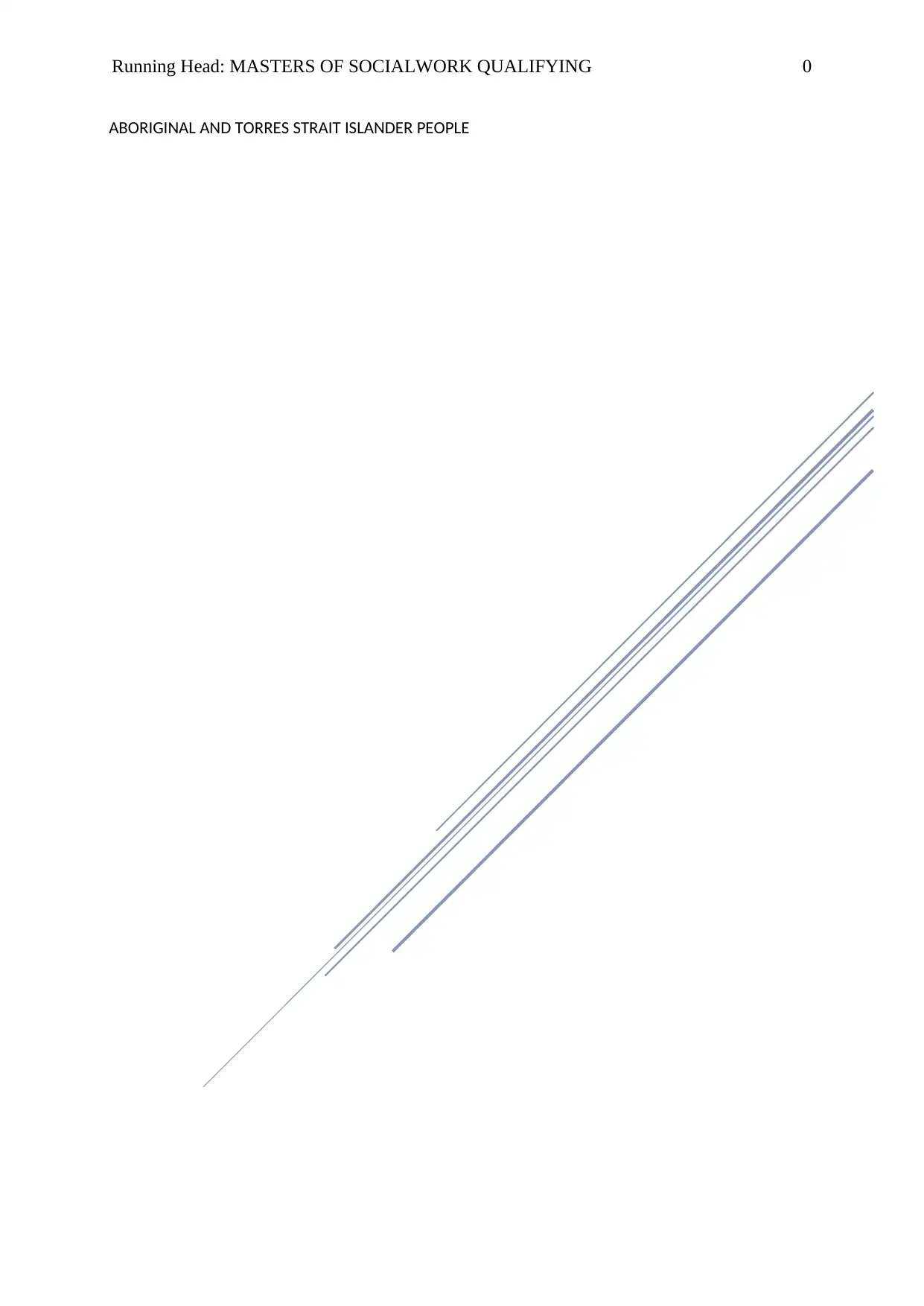
Running Head: MASTERS OF SOCIALWORK QUALIFYING 0
ABORIGINAL AND TORRES STRAIT ISLANDER PEOPLE
ABORIGINAL AND TORRES STRAIT ISLANDER PEOPLE
Secure Best Marks with AI Grader
Need help grading? Try our AI Grader for instant feedback on your assignments.

MASTERS OF SOCIALWORK QUALIFYING 1
Contents
History and current context........................................................................................................2
Political, economic and social issues impact.............................................................................3
Discussion of the major theories................................................................................................5
Current policy and practices.......................................................................................................6
Critique on current policies and practices..................................................................................9
References................................................................................................................................11
Contents
History and current context........................................................................................................2
Political, economic and social issues impact.............................................................................3
Discussion of the major theories................................................................................................5
Current policy and practices.......................................................................................................6
Critique on current policies and practices..................................................................................9
References................................................................................................................................11
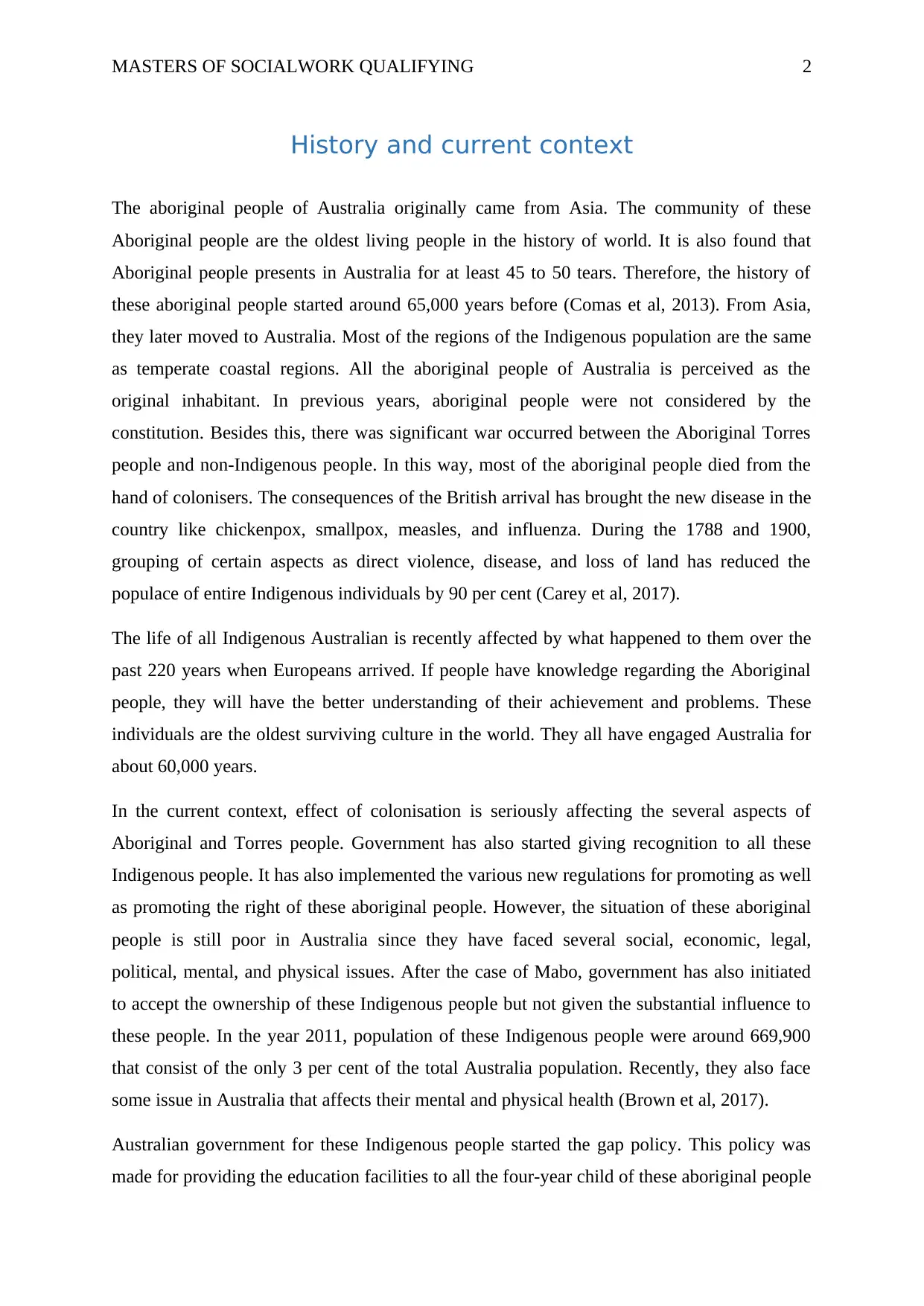
MASTERS OF SOCIALWORK QUALIFYING 2
History and current context
The aboriginal people of Australia originally came from Asia. The community of these
Aboriginal people are the oldest living people in the history of world. It is also found that
Aboriginal people presents in Australia for at least 45 to 50 tears. Therefore, the history of
these aboriginal people started around 65,000 years before (Comas et al, 2013). From Asia,
they later moved to Australia. Most of the regions of the Indigenous population are the same
as temperate coastal regions. All the aboriginal people of Australia is perceived as the
original inhabitant. In previous years, aboriginal people were not considered by the
constitution. Besides this, there was significant war occurred between the Aboriginal Torres
people and non-Indigenous people. In this way, most of the aboriginal people died from the
hand of colonisers. The consequences of the British arrival has brought the new disease in the
country like chickenpox, smallpox, measles, and influenza. During the 1788 and 1900,
grouping of certain aspects as direct violence, disease, and loss of land has reduced the
populace of entire Indigenous individuals by 90 per cent (Carey et al, 2017).
The life of all Indigenous Australian is recently affected by what happened to them over the
past 220 years when Europeans arrived. If people have knowledge regarding the Aboriginal
people, they will have the better understanding of their achievement and problems. These
individuals are the oldest surviving culture in the world. They all have engaged Australia for
about 60,000 years.
In the current context, effect of colonisation is seriously affecting the several aspects of
Aboriginal and Torres people. Government has also started giving recognition to all these
Indigenous people. It has also implemented the various new regulations for promoting as well
as promoting the right of these aboriginal people. However, the situation of these aboriginal
people is still poor in Australia since they have faced several social, economic, legal,
political, mental, and physical issues. After the case of Mabo, government has also initiated
to accept the ownership of these Indigenous people but not given the substantial influence to
these people. In the year 2011, population of these Indigenous people were around 669,900
that consist of the only 3 per cent of the total Australia population. Recently, they also face
some issue in Australia that affects their mental and physical health (Brown et al, 2017).
Australian government for these Indigenous people started the gap policy. This policy was
made for providing the education facilities to all the four-year child of these aboriginal people
History and current context
The aboriginal people of Australia originally came from Asia. The community of these
Aboriginal people are the oldest living people in the history of world. It is also found that
Aboriginal people presents in Australia for at least 45 to 50 tears. Therefore, the history of
these aboriginal people started around 65,000 years before (Comas et al, 2013). From Asia,
they later moved to Australia. Most of the regions of the Indigenous population are the same
as temperate coastal regions. All the aboriginal people of Australia is perceived as the
original inhabitant. In previous years, aboriginal people were not considered by the
constitution. Besides this, there was significant war occurred between the Aboriginal Torres
people and non-Indigenous people. In this way, most of the aboriginal people died from the
hand of colonisers. The consequences of the British arrival has brought the new disease in the
country like chickenpox, smallpox, measles, and influenza. During the 1788 and 1900,
grouping of certain aspects as direct violence, disease, and loss of land has reduced the
populace of entire Indigenous individuals by 90 per cent (Carey et al, 2017).
The life of all Indigenous Australian is recently affected by what happened to them over the
past 220 years when Europeans arrived. If people have knowledge regarding the Aboriginal
people, they will have the better understanding of their achievement and problems. These
individuals are the oldest surviving culture in the world. They all have engaged Australia for
about 60,000 years.
In the current context, effect of colonisation is seriously affecting the several aspects of
Aboriginal and Torres people. Government has also started giving recognition to all these
Indigenous people. It has also implemented the various new regulations for promoting as well
as promoting the right of these aboriginal people. However, the situation of these aboriginal
people is still poor in Australia since they have faced several social, economic, legal,
political, mental, and physical issues. After the case of Mabo, government has also initiated
to accept the ownership of these Indigenous people but not given the substantial influence to
these people. In the year 2011, population of these Indigenous people were around 669,900
that consist of the only 3 per cent of the total Australia population. Recently, they also face
some issue in Australia that affects their mental and physical health (Brown et al, 2017).
Australian government for these Indigenous people started the gap policy. This policy was
made for providing the education facilities to all the four-year child of these aboriginal people
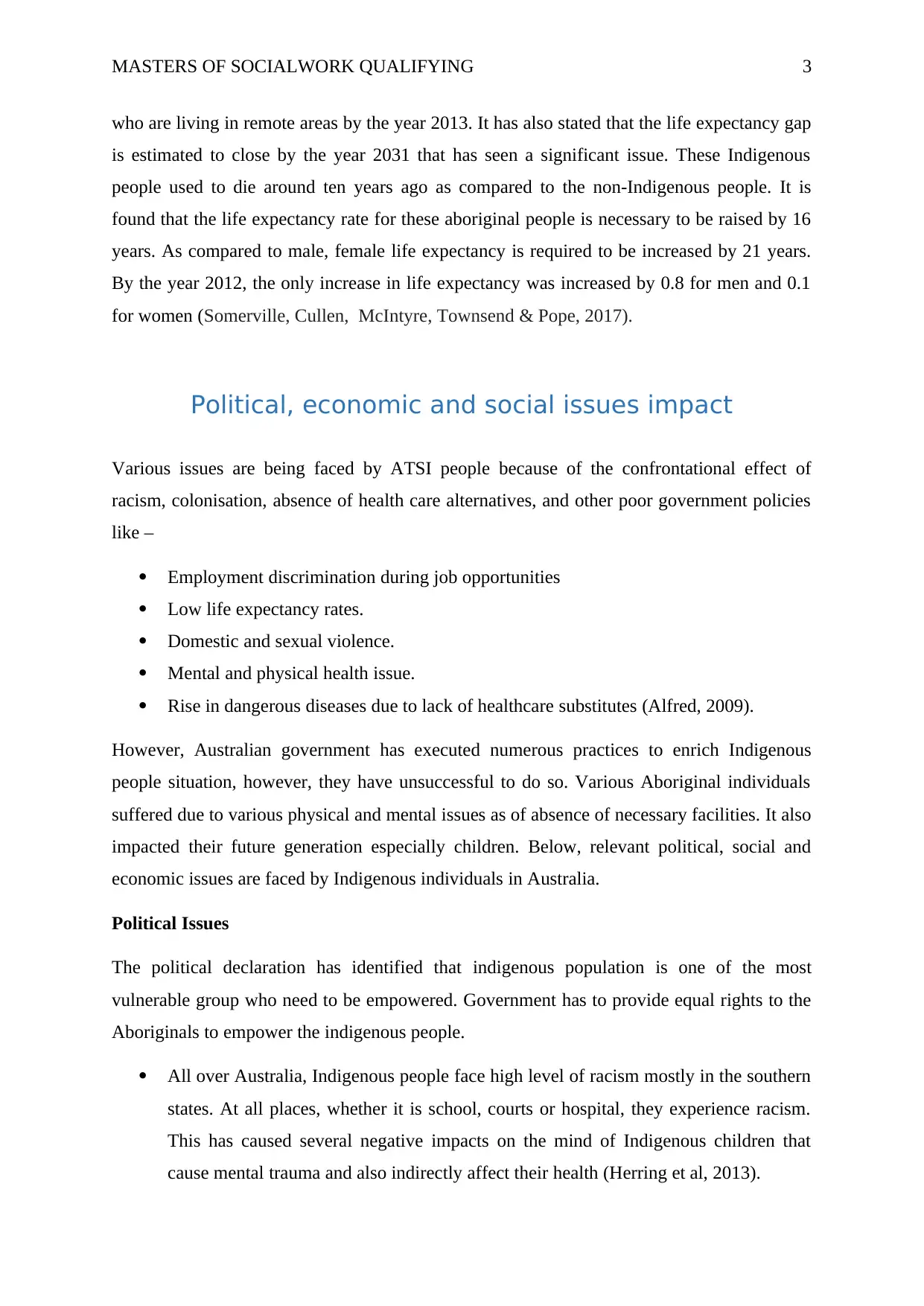
MASTERS OF SOCIALWORK QUALIFYING 3
who are living in remote areas by the year 2013. It has also stated that the life expectancy gap
is estimated to close by the year 2031 that has seen a significant issue. These Indigenous
people used to die around ten years ago as compared to the non-Indigenous people. It is
found that the life expectancy rate for these aboriginal people is necessary to be raised by 16
years. As compared to male, female life expectancy is required to be increased by 21 years.
By the year 2012, the only increase in life expectancy was increased by 0.8 for men and 0.1
for women (Somerville, Cullen, McIntyre, Townsend & Pope, 2017).
Political, economic and social issues impact
Various issues are being faced by ATSI people because of the confrontational effect of
racism, colonisation, absence of health care alternatives, and other poor government policies
like –
Employment discrimination during job opportunities
Low life expectancy rates.
Domestic and sexual violence.
Mental and physical health issue.
Rise in dangerous diseases due to lack of healthcare substitutes (Alfred, 2009).
However, Australian government has executed numerous practices to enrich Indigenous
people situation, however, they have unsuccessful to do so. Various Aboriginal individuals
suffered due to various physical and mental issues as of absence of necessary facilities. It also
impacted their future generation especially children. Below, relevant political, social and
economic issues are faced by Indigenous individuals in Australia.
Political Issues
The political declaration has identified that indigenous population is one of the most
vulnerable group who need to be empowered. Government has to provide equal rights to the
Aboriginals to empower the indigenous people.
All over Australia, Indigenous people face high level of racism mostly in the southern
states. At all places, whether it is school, courts or hospital, they experience racism.
This has caused several negative impacts on the mind of Indigenous children that
cause mental trauma and also indirectly affect their health (Herring et al, 2013).
who are living in remote areas by the year 2013. It has also stated that the life expectancy gap
is estimated to close by the year 2031 that has seen a significant issue. These Indigenous
people used to die around ten years ago as compared to the non-Indigenous people. It is
found that the life expectancy rate for these aboriginal people is necessary to be raised by 16
years. As compared to male, female life expectancy is required to be increased by 21 years.
By the year 2012, the only increase in life expectancy was increased by 0.8 for men and 0.1
for women (Somerville, Cullen, McIntyre, Townsend & Pope, 2017).
Political, economic and social issues impact
Various issues are being faced by ATSI people because of the confrontational effect of
racism, colonisation, absence of health care alternatives, and other poor government policies
like –
Employment discrimination during job opportunities
Low life expectancy rates.
Domestic and sexual violence.
Mental and physical health issue.
Rise in dangerous diseases due to lack of healthcare substitutes (Alfred, 2009).
However, Australian government has executed numerous practices to enrich Indigenous
people situation, however, they have unsuccessful to do so. Various Aboriginal individuals
suffered due to various physical and mental issues as of absence of necessary facilities. It also
impacted their future generation especially children. Below, relevant political, social and
economic issues are faced by Indigenous individuals in Australia.
Political Issues
The political declaration has identified that indigenous population is one of the most
vulnerable group who need to be empowered. Government has to provide equal rights to the
Aboriginals to empower the indigenous people.
All over Australia, Indigenous people face high level of racism mostly in the southern
states. At all places, whether it is school, courts or hospital, they experience racism.
This has caused several negative impacts on the mind of Indigenous children that
cause mental trauma and also indirectly affect their health (Herring et al, 2013).
Secure Best Marks with AI Grader
Need help grading? Try our AI Grader for instant feedback on your assignments.
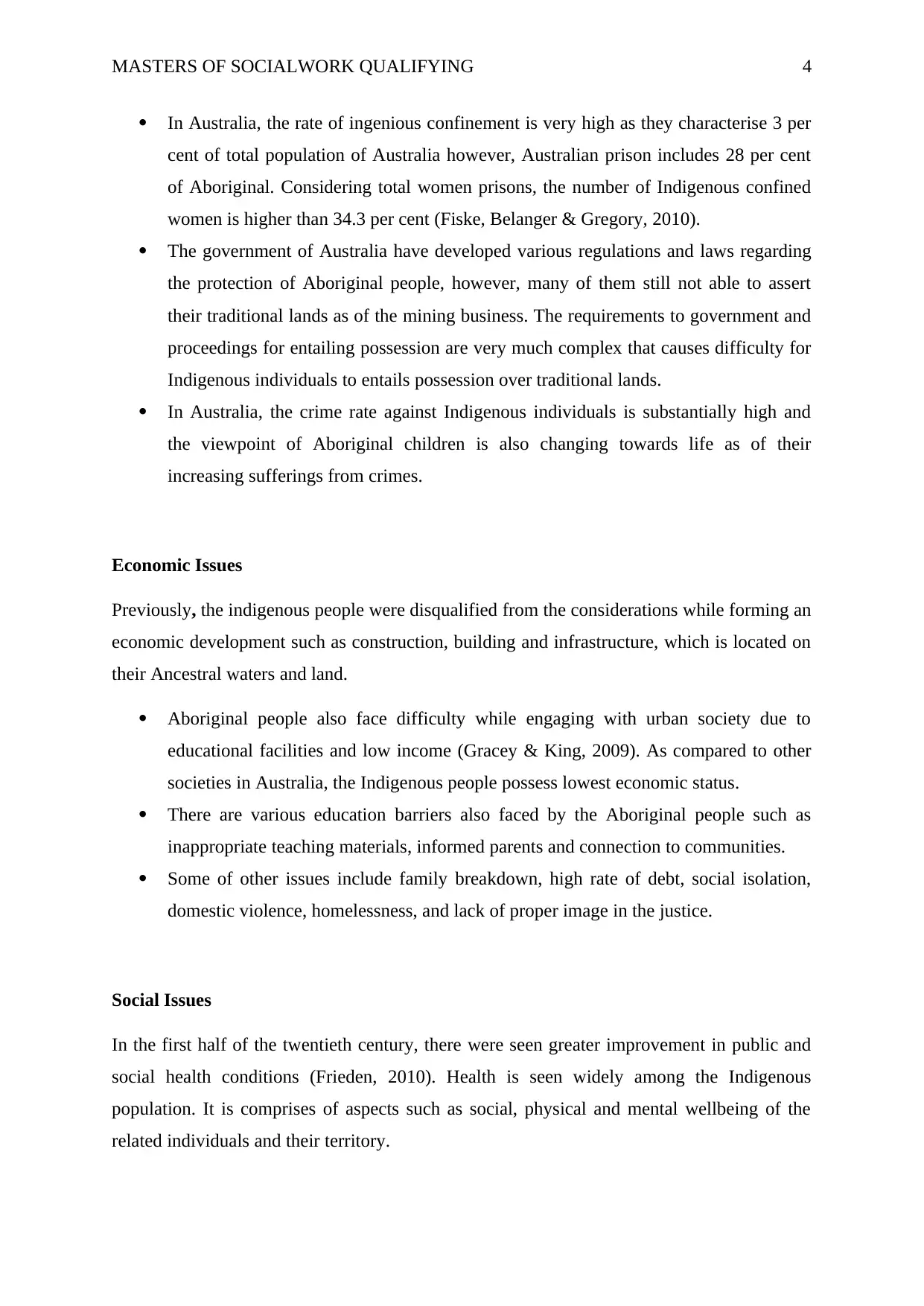
MASTERS OF SOCIALWORK QUALIFYING 4
In Australia, the rate of ingenious confinement is very high as they characterise 3 per
cent of total population of Australia however, Australian prison includes 28 per cent
of Aboriginal. Considering total women prisons, the number of Indigenous confined
women is higher than 34.3 per cent (Fiske, Belanger & Gregory, 2010).
The government of Australia have developed various regulations and laws regarding
the protection of Aboriginal people, however, many of them still not able to assert
their traditional lands as of the mining business. The requirements to government and
proceedings for entailing possession are very much complex that causes difficulty for
Indigenous individuals to entails possession over traditional lands.
In Australia, the crime rate against Indigenous individuals is substantially high and
the viewpoint of Aboriginal children is also changing towards life as of their
increasing sufferings from crimes.
Economic Issues
Previously, the indigenous people were disqualified from the considerations while forming an
economic development such as construction, building and infrastructure, which is located on
their Ancestral waters and land.
Aboriginal people also face difficulty while engaging with urban society due to
educational facilities and low income (Gracey & King, 2009). As compared to other
societies in Australia, the Indigenous people possess lowest economic status.
There are various education barriers also faced by the Aboriginal people such as
inappropriate teaching materials, informed parents and connection to communities.
Some of other issues include family breakdown, high rate of debt, social isolation,
domestic violence, homelessness, and lack of proper image in the justice.
Social Issues
In the first half of the twentieth century, there were seen greater improvement in public and
social health conditions (Frieden, 2010). Health is seen widely among the Indigenous
population. It is comprises of aspects such as social, physical and mental wellbeing of the
related individuals and their territory.
In Australia, the rate of ingenious confinement is very high as they characterise 3 per
cent of total population of Australia however, Australian prison includes 28 per cent
of Aboriginal. Considering total women prisons, the number of Indigenous confined
women is higher than 34.3 per cent (Fiske, Belanger & Gregory, 2010).
The government of Australia have developed various regulations and laws regarding
the protection of Aboriginal people, however, many of them still not able to assert
their traditional lands as of the mining business. The requirements to government and
proceedings for entailing possession are very much complex that causes difficulty for
Indigenous individuals to entails possession over traditional lands.
In Australia, the crime rate against Indigenous individuals is substantially high and
the viewpoint of Aboriginal children is also changing towards life as of their
increasing sufferings from crimes.
Economic Issues
Previously, the indigenous people were disqualified from the considerations while forming an
economic development such as construction, building and infrastructure, which is located on
their Ancestral waters and land.
Aboriginal people also face difficulty while engaging with urban society due to
educational facilities and low income (Gracey & King, 2009). As compared to other
societies in Australia, the Indigenous people possess lowest economic status.
There are various education barriers also faced by the Aboriginal people such as
inappropriate teaching materials, informed parents and connection to communities.
Some of other issues include family breakdown, high rate of debt, social isolation,
domestic violence, homelessness, and lack of proper image in the justice.
Social Issues
In the first half of the twentieth century, there were seen greater improvement in public and
social health conditions (Frieden, 2010). Health is seen widely among the Indigenous
population. It is comprises of aspects such as social, physical and mental wellbeing of the
related individuals and their territory.
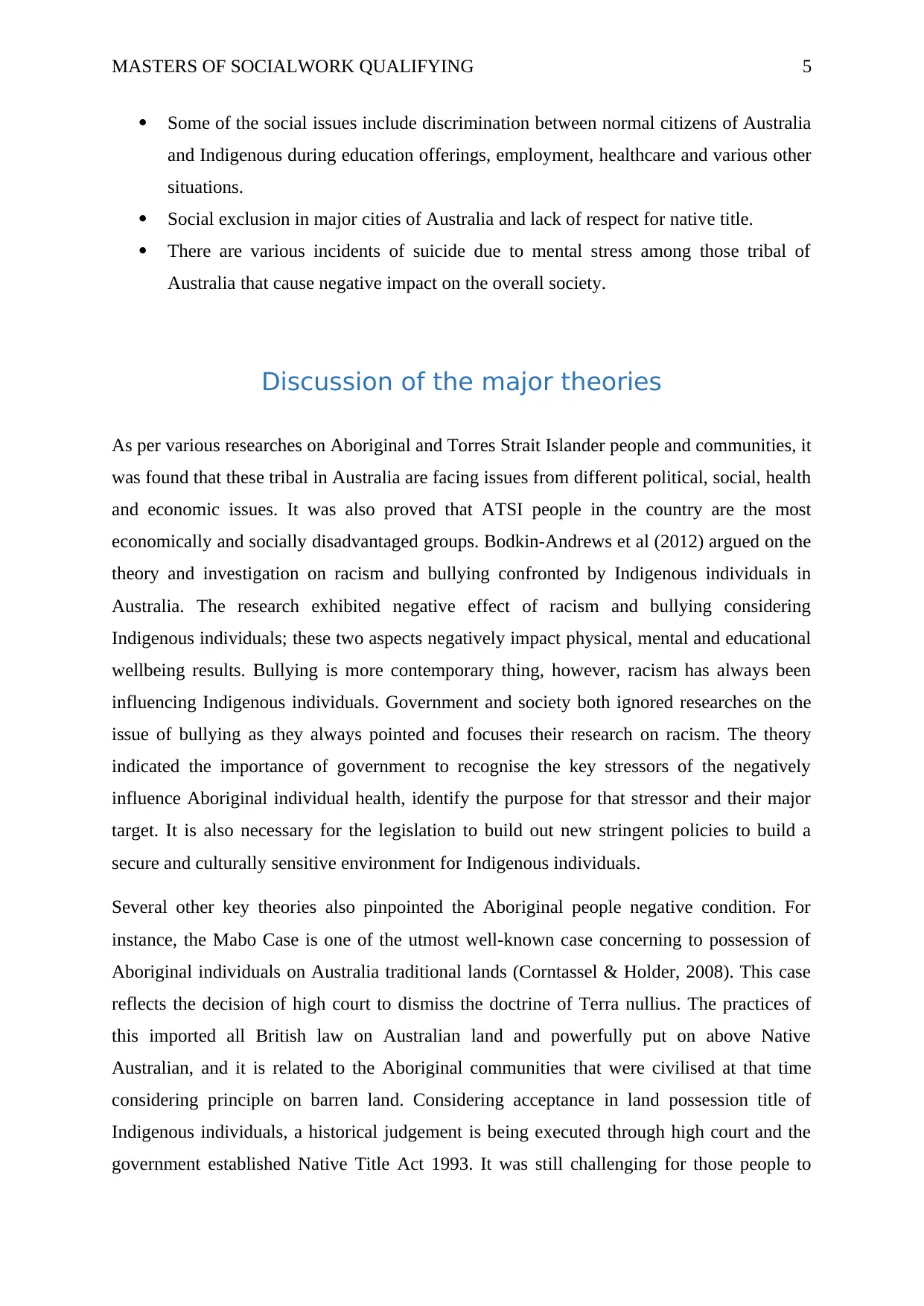
MASTERS OF SOCIALWORK QUALIFYING 5
Some of the social issues include discrimination between normal citizens of Australia
and Indigenous during education offerings, employment, healthcare and various other
situations.
Social exclusion in major cities of Australia and lack of respect for native title.
There are various incidents of suicide due to mental stress among those tribal of
Australia that cause negative impact on the overall society.
Discussion of the major theories
As per various researches on Aboriginal and Torres Strait Islander people and communities, it
was found that these tribal in Australia are facing issues from different political, social, health
and economic issues. It was also proved that ATSI people in the country are the most
economically and socially disadvantaged groups. Bodkin-Andrews et al (2012) argued on the
theory and investigation on racism and bullying confronted by Indigenous individuals in
Australia. The research exhibited negative effect of racism and bullying considering
Indigenous individuals; these two aspects negatively impact physical, mental and educational
wellbeing results. Bullying is more contemporary thing, however, racism has always been
influencing Indigenous individuals. Government and society both ignored researches on the
issue of bullying as they always pointed and focuses their research on racism. The theory
indicated the importance of government to recognise the key stressors of the negatively
influence Aboriginal individual health, identify the purpose for that stressor and their major
target. It is also necessary for the legislation to build out new stringent policies to build a
secure and culturally sensitive environment for Indigenous individuals.
Several other key theories also pinpointed the Aboriginal people negative condition. For
instance, the Mabo Case is one of the utmost well-known case concerning to possession of
Aboriginal individuals on Australia traditional lands (Corntassel & Holder, 2008). This case
reflects the decision of high court to dismiss the doctrine of Terra nullius. The practices of
this imported all British law on Australian land and powerfully put on above Native
Australian, and it is related to the Aboriginal communities that were civilised at that time
considering principle on barren land. Considering acceptance in land possession title of
Indigenous individuals, a historical judgement is being executed through high court and the
government established Native Title Act 1993. It was still challenging for those people to
Some of the social issues include discrimination between normal citizens of Australia
and Indigenous during education offerings, employment, healthcare and various other
situations.
Social exclusion in major cities of Australia and lack of respect for native title.
There are various incidents of suicide due to mental stress among those tribal of
Australia that cause negative impact on the overall society.
Discussion of the major theories
As per various researches on Aboriginal and Torres Strait Islander people and communities, it
was found that these tribal in Australia are facing issues from different political, social, health
and economic issues. It was also proved that ATSI people in the country are the most
economically and socially disadvantaged groups. Bodkin-Andrews et al (2012) argued on the
theory and investigation on racism and bullying confronted by Indigenous individuals in
Australia. The research exhibited negative effect of racism and bullying considering
Indigenous individuals; these two aspects negatively impact physical, mental and educational
wellbeing results. Bullying is more contemporary thing, however, racism has always been
influencing Indigenous individuals. Government and society both ignored researches on the
issue of bullying as they always pointed and focuses their research on racism. The theory
indicated the importance of government to recognise the key stressors of the negatively
influence Aboriginal individual health, identify the purpose for that stressor and their major
target. It is also necessary for the legislation to build out new stringent policies to build a
secure and culturally sensitive environment for Indigenous individuals.
Several other key theories also pinpointed the Aboriginal people negative condition. For
instance, the Mabo Case is one of the utmost well-known case concerning to possession of
Aboriginal individuals on Australia traditional lands (Corntassel & Holder, 2008). This case
reflects the decision of high court to dismiss the doctrine of Terra nullius. The practices of
this imported all British law on Australian land and powerfully put on above Native
Australian, and it is related to the Aboriginal communities that were civilised at that time
considering principle on barren land. Considering acceptance in land possession title of
Indigenous individuals, a historical judgement is being executed through high court and the
government established Native Title Act 1993. It was still challenging for those people to
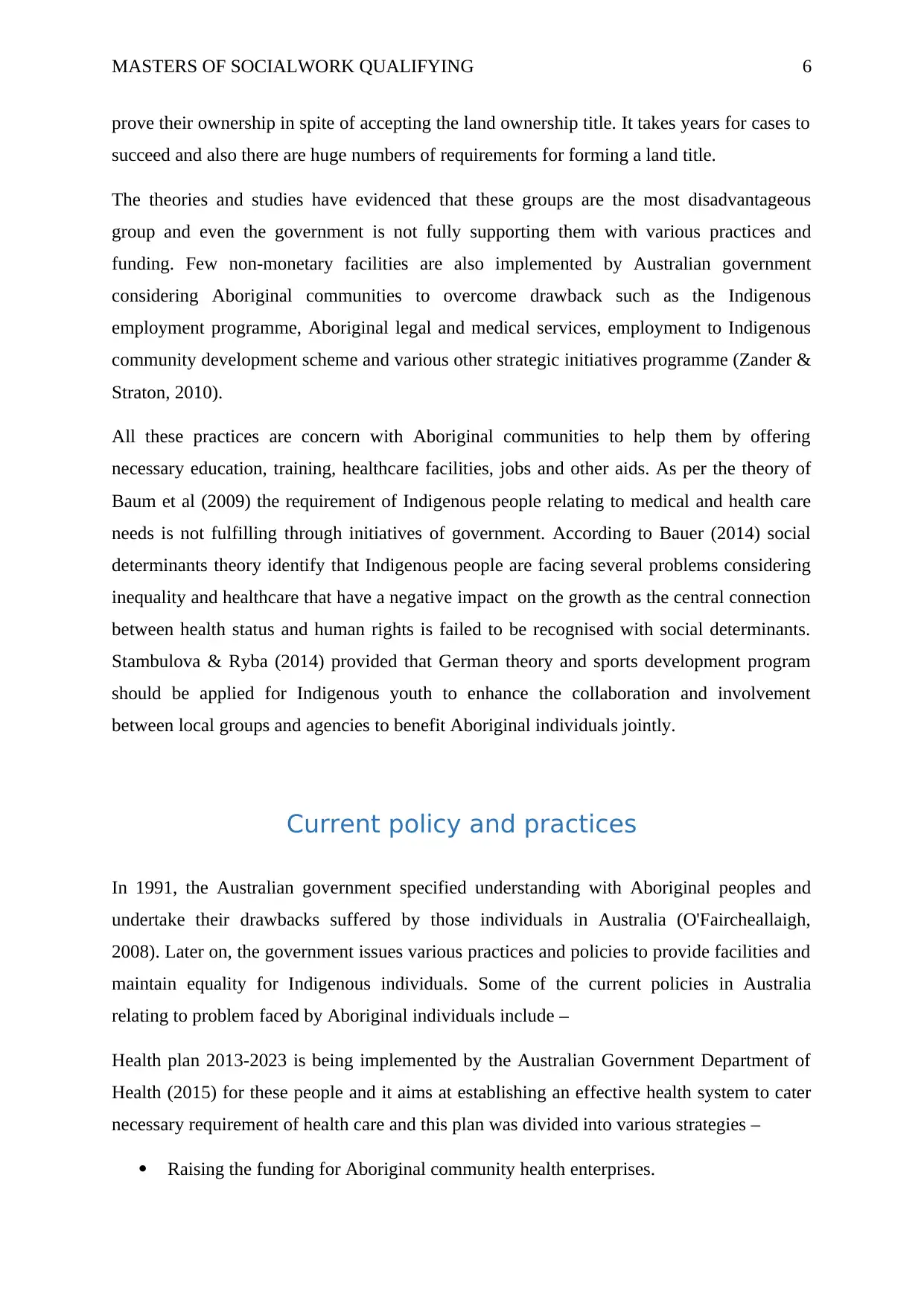
MASTERS OF SOCIALWORK QUALIFYING 6
prove their ownership in spite of accepting the land ownership title. It takes years for cases to
succeed and also there are huge numbers of requirements for forming a land title.
The theories and studies have evidenced that these groups are the most disadvantageous
group and even the government is not fully supporting them with various practices and
funding. Few non-monetary facilities are also implemented by Australian government
considering Aboriginal communities to overcome drawback such as the Indigenous
employment programme, Aboriginal legal and medical services, employment to Indigenous
community development scheme and various other strategic initiatives programme (Zander &
Straton, 2010).
All these practices are concern with Aboriginal communities to help them by offering
necessary education, training, healthcare facilities, jobs and other aids. As per the theory of
Baum et al (2009) the requirement of Indigenous people relating to medical and health care
needs is not fulfilling through initiatives of government. According to Bauer (2014) social
determinants theory identify that Indigenous people are facing several problems considering
inequality and healthcare that have a negative impact on the growth as the central connection
between health status and human rights is failed to be recognised with social determinants.
Stambulova & Ryba (2014) provided that German theory and sports development program
should be applied for Indigenous youth to enhance the collaboration and involvement
between local groups and agencies to benefit Aboriginal individuals jointly.
Current policy and practices
In 1991, the Australian government specified understanding with Aboriginal peoples and
undertake their drawbacks suffered by those individuals in Australia (O'Faircheallaigh,
2008). Later on, the government issues various practices and policies to provide facilities and
maintain equality for Indigenous individuals. Some of the current policies in Australia
relating to problem faced by Aboriginal individuals include –
Health plan 2013-2023 is being implemented by the Australian Government Department of
Health (2015) for these people and it aims at establishing an effective health system to cater
necessary requirement of health care and this plan was divided into various strategies –
Raising the funding for Aboriginal community health enterprises.
prove their ownership in spite of accepting the land ownership title. It takes years for cases to
succeed and also there are huge numbers of requirements for forming a land title.
The theories and studies have evidenced that these groups are the most disadvantageous
group and even the government is not fully supporting them with various practices and
funding. Few non-monetary facilities are also implemented by Australian government
considering Aboriginal communities to overcome drawback such as the Indigenous
employment programme, Aboriginal legal and medical services, employment to Indigenous
community development scheme and various other strategic initiatives programme (Zander &
Straton, 2010).
All these practices are concern with Aboriginal communities to help them by offering
necessary education, training, healthcare facilities, jobs and other aids. As per the theory of
Baum et al (2009) the requirement of Indigenous people relating to medical and health care
needs is not fulfilling through initiatives of government. According to Bauer (2014) social
determinants theory identify that Indigenous people are facing several problems considering
inequality and healthcare that have a negative impact on the growth as the central connection
between health status and human rights is failed to be recognised with social determinants.
Stambulova & Ryba (2014) provided that German theory and sports development program
should be applied for Indigenous youth to enhance the collaboration and involvement
between local groups and agencies to benefit Aboriginal individuals jointly.
Current policy and practices
In 1991, the Australian government specified understanding with Aboriginal peoples and
undertake their drawbacks suffered by those individuals in Australia (O'Faircheallaigh,
2008). Later on, the government issues various practices and policies to provide facilities and
maintain equality for Indigenous individuals. Some of the current policies in Australia
relating to problem faced by Aboriginal individuals include –
Health plan 2013-2023 is being implemented by the Australian Government Department of
Health (2015) for these people and it aims at establishing an effective health system to cater
necessary requirement of health care and this plan was divided into various strategies –
Raising the funding for Aboriginal community health enterprises.
Paraphrase This Document
Need a fresh take? Get an instant paraphrase of this document with our AI Paraphraser
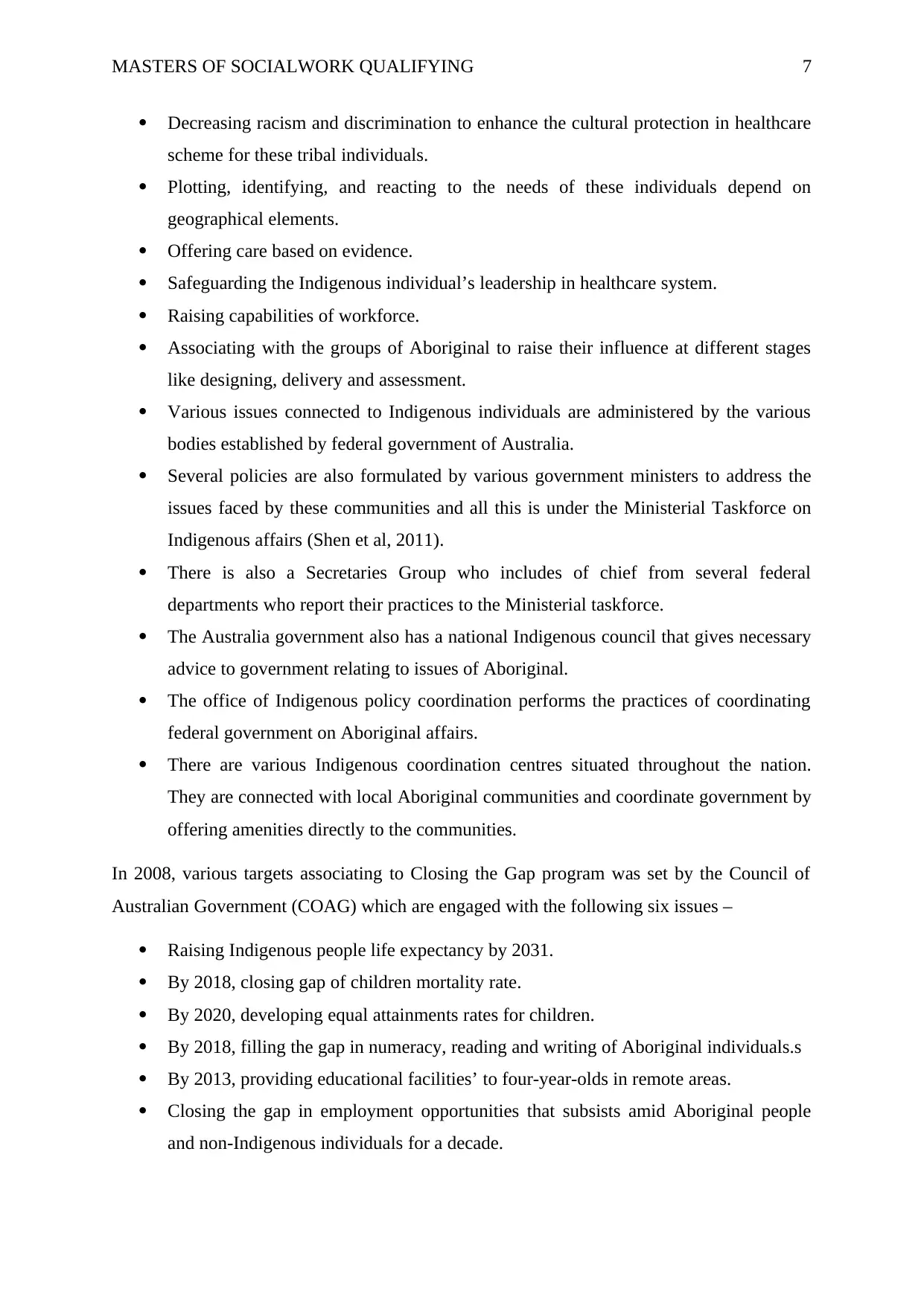
MASTERS OF SOCIALWORK QUALIFYING 7
Decreasing racism and discrimination to enhance the cultural protection in healthcare
scheme for these tribal individuals.
Plotting, identifying, and reacting to the needs of these individuals depend on
geographical elements.
Offering care based on evidence.
Safeguarding the Indigenous individual’s leadership in healthcare system.
Raising capabilities of workforce.
Associating with the groups of Aboriginal to raise their influence at different stages
like designing, delivery and assessment.
Various issues connected to Indigenous individuals are administered by the various
bodies established by federal government of Australia.
Several policies are also formulated by various government ministers to address the
issues faced by these communities and all this is under the Ministerial Taskforce on
Indigenous affairs (Shen et al, 2011).
There is also a Secretaries Group who includes of chief from several federal
departments who report their practices to the Ministerial taskforce.
The Australia government also has a national Indigenous council that gives necessary
advice to government relating to issues of Aboriginal.
The office of Indigenous policy coordination performs the practices of coordinating
federal government on Aboriginal affairs.
There are various Indigenous coordination centres situated throughout the nation.
They are connected with local Aboriginal communities and coordinate government by
offering amenities directly to the communities.
In 2008, various targets associating to Closing the Gap program was set by the Council of
Australian Government (COAG) which are engaged with the following six issues –
Raising Indigenous people life expectancy by 2031.
By 2018, closing gap of children mortality rate.
By 2020, developing equal attainments rates for children.
By 2018, filling the gap in numeracy, reading and writing of Aboriginal individuals.s
By 2013, providing educational facilities’ to four-year-olds in remote areas.
Closing the gap in employment opportunities that subsists amid Aboriginal people
and non-Indigenous individuals for a decade.
Decreasing racism and discrimination to enhance the cultural protection in healthcare
scheme for these tribal individuals.
Plotting, identifying, and reacting to the needs of these individuals depend on
geographical elements.
Offering care based on evidence.
Safeguarding the Indigenous individual’s leadership in healthcare system.
Raising capabilities of workforce.
Associating with the groups of Aboriginal to raise their influence at different stages
like designing, delivery and assessment.
Various issues connected to Indigenous individuals are administered by the various
bodies established by federal government of Australia.
Several policies are also formulated by various government ministers to address the
issues faced by these communities and all this is under the Ministerial Taskforce on
Indigenous affairs (Shen et al, 2011).
There is also a Secretaries Group who includes of chief from several federal
departments who report their practices to the Ministerial taskforce.
The Australia government also has a national Indigenous council that gives necessary
advice to government relating to issues of Aboriginal.
The office of Indigenous policy coordination performs the practices of coordinating
federal government on Aboriginal affairs.
There are various Indigenous coordination centres situated throughout the nation.
They are connected with local Aboriginal communities and coordinate government by
offering amenities directly to the communities.
In 2008, various targets associating to Closing the Gap program was set by the Council of
Australian Government (COAG) which are engaged with the following six issues –
Raising Indigenous people life expectancy by 2031.
By 2018, closing gap of children mortality rate.
By 2020, developing equal attainments rates for children.
By 2018, filling the gap in numeracy, reading and writing of Aboriginal individuals.s
By 2013, providing educational facilities’ to four-year-olds in remote areas.
Closing the gap in employment opportunities that subsists amid Aboriginal people
and non-Indigenous individuals for a decade.

MASTERS OF SOCIALWORK QUALIFYING 8
Five new targets were also added by COAG in 2014 to close the gap and around $4.8
billion were invested by the government of Australia in its program called as
Indigenous Advancement Strategy (IAS) so as to come on five programs by replacing
more than 150 programs includes –
1. Culture capability
2. Wellbeing and Safety
3. Education and children
4. Remote Australia strategy
5. Land, job and economy
6. Formation of Native Title Act 1993 that identify the possession title of
Aboriginal individuals over old lands and giving them ownership of such plots
(Simpson, 2010)
7. Non-Indigenous individuals and the government are not recognising the
Aboriginal people drawbacks rapidly and they are scattering consciousness to
offer them equivalent prospects by decreasing discrimination and racism with
the policies like self-determination policy, citizenship, land rights and native
title.
Five new targets were also added by COAG in 2014 to close the gap and around $4.8
billion were invested by the government of Australia in its program called as
Indigenous Advancement Strategy (IAS) so as to come on five programs by replacing
more than 150 programs includes –
1. Culture capability
2. Wellbeing and Safety
3. Education and children
4. Remote Australia strategy
5. Land, job and economy
6. Formation of Native Title Act 1993 that identify the possession title of
Aboriginal individuals over old lands and giving them ownership of such plots
(Simpson, 2010)
7. Non-Indigenous individuals and the government are not recognising the
Aboriginal people drawbacks rapidly and they are scattering consciousness to
offer them equivalent prospects by decreasing discrimination and racism with
the policies like self-determination policy, citizenship, land rights and native
title.
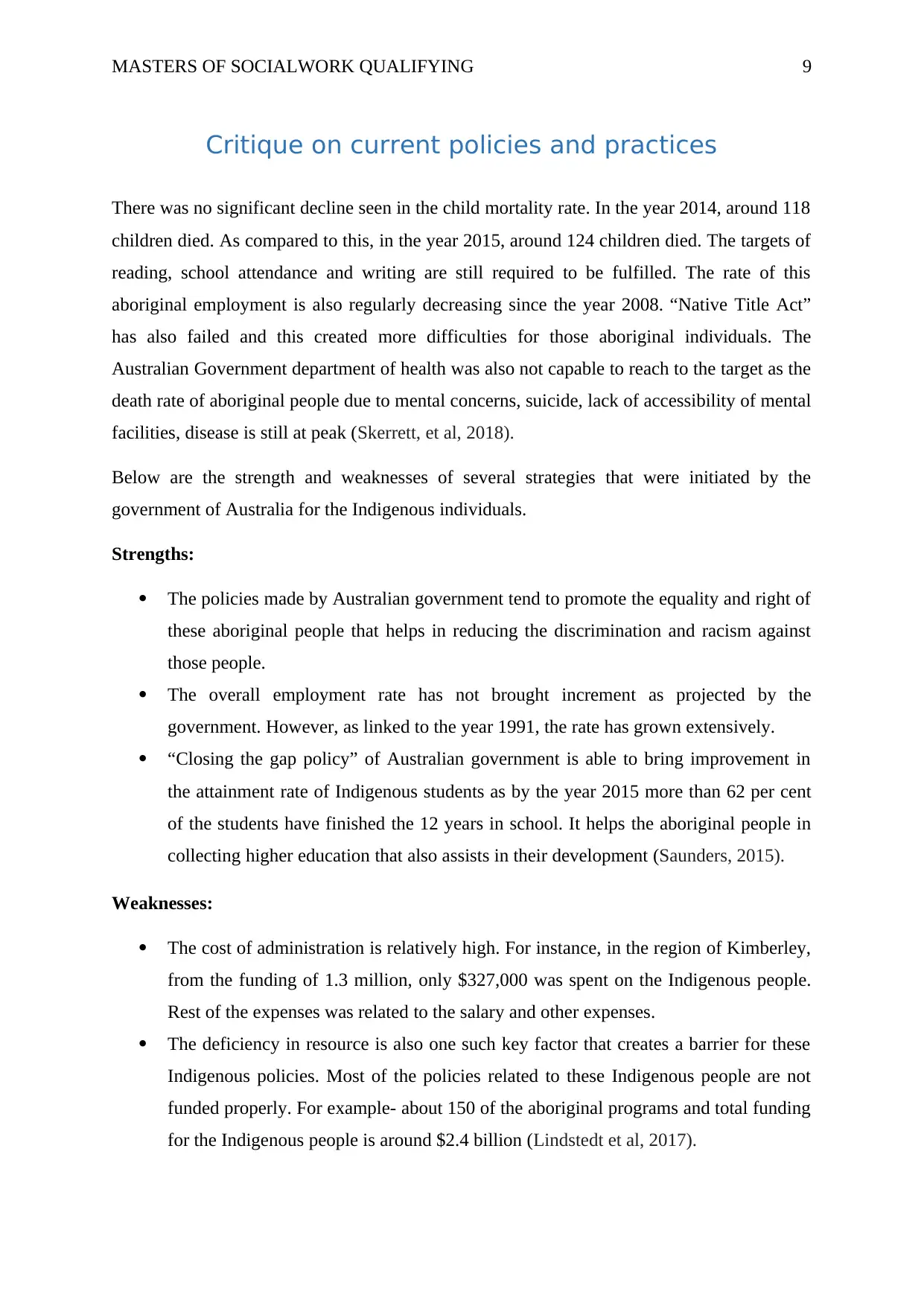
MASTERS OF SOCIALWORK QUALIFYING 9
Critique on current policies and practices
There was no significant decline seen in the child mortality rate. In the year 2014, around 118
children died. As compared to this, in the year 2015, around 124 children died. The targets of
reading, school attendance and writing are still required to be fulfilled. The rate of this
aboriginal employment is also regularly decreasing since the year 2008. “Native Title Act”
has also failed and this created more difficulties for those aboriginal individuals. The
Australian Government department of health was also not capable to reach to the target as the
death rate of aboriginal people due to mental concerns, suicide, lack of accessibility of mental
facilities, disease is still at peak (Skerrett, et al, 2018).
Below are the strength and weaknesses of several strategies that were initiated by the
government of Australia for the Indigenous individuals.
Strengths:
The policies made by Australian government tend to promote the equality and right of
these aboriginal people that helps in reducing the discrimination and racism against
those people.
The overall employment rate has not brought increment as projected by the
government. However, as linked to the year 1991, the rate has grown extensively.
“Closing the gap policy” of Australian government is able to bring improvement in
the attainment rate of Indigenous students as by the year 2015 more than 62 per cent
of the students have finished the 12 years in school. It helps the aboriginal people in
collecting higher education that also assists in their development (Saunders, 2015).
Weaknesses:
The cost of administration is relatively high. For instance, in the region of Kimberley,
from the funding of 1.3 million, only $327,000 was spent on the Indigenous people.
Rest of the expenses was related to the salary and other expenses.
The deficiency in resource is also one such key factor that creates a barrier for these
Indigenous policies. Most of the policies related to these Indigenous people are not
funded properly. For example- about 150 of the aboriginal programs and total funding
for the Indigenous people is around $2.4 billion (Lindstedt et al, 2017).
Critique on current policies and practices
There was no significant decline seen in the child mortality rate. In the year 2014, around 118
children died. As compared to this, in the year 2015, around 124 children died. The targets of
reading, school attendance and writing are still required to be fulfilled. The rate of this
aboriginal employment is also regularly decreasing since the year 2008. “Native Title Act”
has also failed and this created more difficulties for those aboriginal individuals. The
Australian Government department of health was also not capable to reach to the target as the
death rate of aboriginal people due to mental concerns, suicide, lack of accessibility of mental
facilities, disease is still at peak (Skerrett, et al, 2018).
Below are the strength and weaknesses of several strategies that were initiated by the
government of Australia for the Indigenous individuals.
Strengths:
The policies made by Australian government tend to promote the equality and right of
these aboriginal people that helps in reducing the discrimination and racism against
those people.
The overall employment rate has not brought increment as projected by the
government. However, as linked to the year 1991, the rate has grown extensively.
“Closing the gap policy” of Australian government is able to bring improvement in
the attainment rate of Indigenous students as by the year 2015 more than 62 per cent
of the students have finished the 12 years in school. It helps the aboriginal people in
collecting higher education that also assists in their development (Saunders, 2015).
Weaknesses:
The cost of administration is relatively high. For instance, in the region of Kimberley,
from the funding of 1.3 million, only $327,000 was spent on the Indigenous people.
Rest of the expenses was related to the salary and other expenses.
The deficiency in resource is also one such key factor that creates a barrier for these
Indigenous policies. Most of the policies related to these Indigenous people are not
funded properly. For example- about 150 of the aboriginal programs and total funding
for the Indigenous people is around $2.4 billion (Lindstedt et al, 2017).
Secure Best Marks with AI Grader
Need help grading? Try our AI Grader for instant feedback on your assignments.
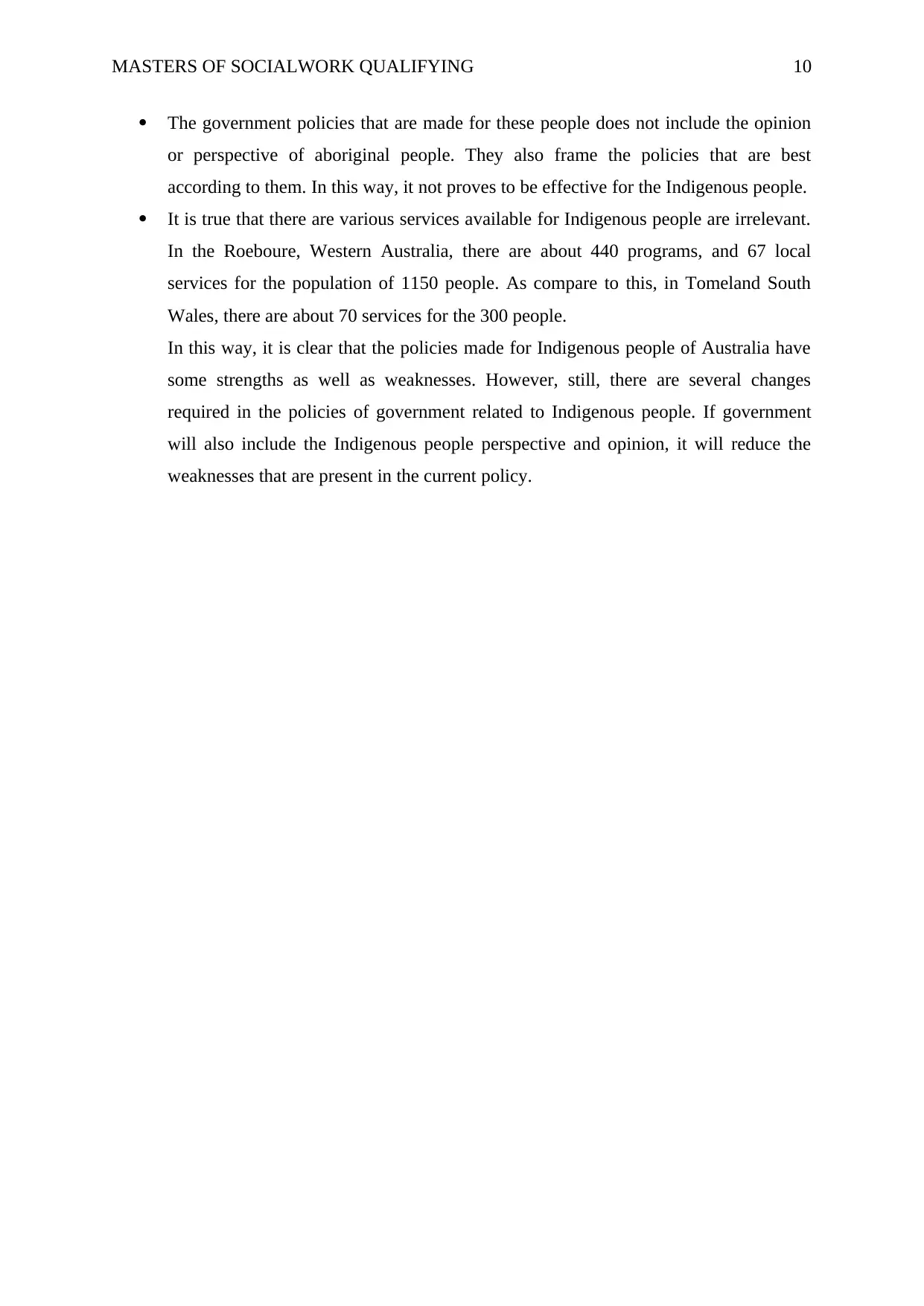
MASTERS OF SOCIALWORK QUALIFYING 10
The government policies that are made for these people does not include the opinion
or perspective of aboriginal people. They also frame the policies that are best
according to them. In this way, it not proves to be effective for the Indigenous people.
It is true that there are various services available for Indigenous people are irrelevant.
In the Roeboure, Western Australia, there are about 440 programs, and 67 local
services for the population of 1150 people. As compare to this, in Tomeland South
Wales, there are about 70 services for the 300 people.
In this way, it is clear that the policies made for Indigenous people of Australia have
some strengths as well as weaknesses. However, still, there are several changes
required in the policies of government related to Indigenous people. If government
will also include the Indigenous people perspective and opinion, it will reduce the
weaknesses that are present in the current policy.
The government policies that are made for these people does not include the opinion
or perspective of aboriginal people. They also frame the policies that are best
according to them. In this way, it not proves to be effective for the Indigenous people.
It is true that there are various services available for Indigenous people are irrelevant.
In the Roeboure, Western Australia, there are about 440 programs, and 67 local
services for the population of 1150 people. As compare to this, in Tomeland South
Wales, there are about 70 services for the 300 people.
In this way, it is clear that the policies made for Indigenous people of Australia have
some strengths as well as weaknesses. However, still, there are several changes
required in the policies of government related to Indigenous people. If government
will also include the Indigenous people perspective and opinion, it will reduce the
weaknesses that are present in the current policy.

MASTERS OF SOCIALWORK QUALIFYING 11
References
Alfred, G. T. (2009). Colonialism and state dependency. International Journal of Indigenous
Health, 5(2), 42-60.
Bauer, G. R. (2014). Incorporating intersectionality theory into population health research
methodology: challenges and the potential to advance health equity. Social science &
medicine, 110(1), 10-17.
Baum, F. E., Begin, M., Houweling, T. A., & Taylor, S. (2009). Changes not for the
fainthearted: reorienting health care systems toward health equity through action on
the social determinants of health. American journal of public health, 99(11), 1967-
1974.
Bodkin-Andrews, G., Paradies, Y., Parada, R., Denson, N., Priest, N., & Bansel, P. (2012).
Theory and research on bullying and racism from an Aboriginal Australian
perspective. In AARE 2012: Proceedings of the Australian Association for Research
in Education 2012 conference (pp. 1-14). Australian Association for Research in
Education.
Brown, L., Osborne, K., Walker, R., Moskos, M., Isherwood, L., Patel, K., Baum, F. and
King, D. (2017) The benefits of a life-first employment program for Indigenous
Australian families: Implications for ‘Closing the Gap’. Journal of Social
Inclusion, 8(1), pp.78-95.
Carey, T. A., Dudgeon, P., Hammond, S. W., Hirvonen, T., Kyrios, M., Roufeil, L., & Smith,
P. (2017). The Australian Psychological Society's Apology to Aboriginal and Torres
Strait Islander People. Australian Psychologist, 52(4), 261-267.
Comas, I., Coscolla, M., Luo, T., Borrell, S., Holt, K. E., Kato-Maeda, M., ... & Yeboah-
Manu, D. (2013). Out-of-Africa migration and Neolithic coexpansion of
Mycobacterium tuberculosis with modern humans. Nature genetics, 45(10), 1176.
Corntassel, J., & Holder, C. (2008). Who’s sorry now? Government apologies, truth
commissions, and Indigenous self-determination in Australia, Canada, Guatemala,
and Peru. Human rights review, 9(4), 465-489.
References
Alfred, G. T. (2009). Colonialism and state dependency. International Journal of Indigenous
Health, 5(2), 42-60.
Bauer, G. R. (2014). Incorporating intersectionality theory into population health research
methodology: challenges and the potential to advance health equity. Social science &
medicine, 110(1), 10-17.
Baum, F. E., Begin, M., Houweling, T. A., & Taylor, S. (2009). Changes not for the
fainthearted: reorienting health care systems toward health equity through action on
the social determinants of health. American journal of public health, 99(11), 1967-
1974.
Bodkin-Andrews, G., Paradies, Y., Parada, R., Denson, N., Priest, N., & Bansel, P. (2012).
Theory and research on bullying and racism from an Aboriginal Australian
perspective. In AARE 2012: Proceedings of the Australian Association for Research
in Education 2012 conference (pp. 1-14). Australian Association for Research in
Education.
Brown, L., Osborne, K., Walker, R., Moskos, M., Isherwood, L., Patel, K., Baum, F. and
King, D. (2017) The benefits of a life-first employment program for Indigenous
Australian families: Implications for ‘Closing the Gap’. Journal of Social
Inclusion, 8(1), pp.78-95.
Carey, T. A., Dudgeon, P., Hammond, S. W., Hirvonen, T., Kyrios, M., Roufeil, L., & Smith,
P. (2017). The Australian Psychological Society's Apology to Aboriginal and Torres
Strait Islander People. Australian Psychologist, 52(4), 261-267.
Comas, I., Coscolla, M., Luo, T., Borrell, S., Holt, K. E., Kato-Maeda, M., ... & Yeboah-
Manu, D. (2013). Out-of-Africa migration and Neolithic coexpansion of
Mycobacterium tuberculosis with modern humans. Nature genetics, 45(10), 1176.
Corntassel, J., & Holder, C. (2008). Who’s sorry now? Government apologies, truth
commissions, and Indigenous self-determination in Australia, Canada, Guatemala,
and Peru. Human rights review, 9(4), 465-489.
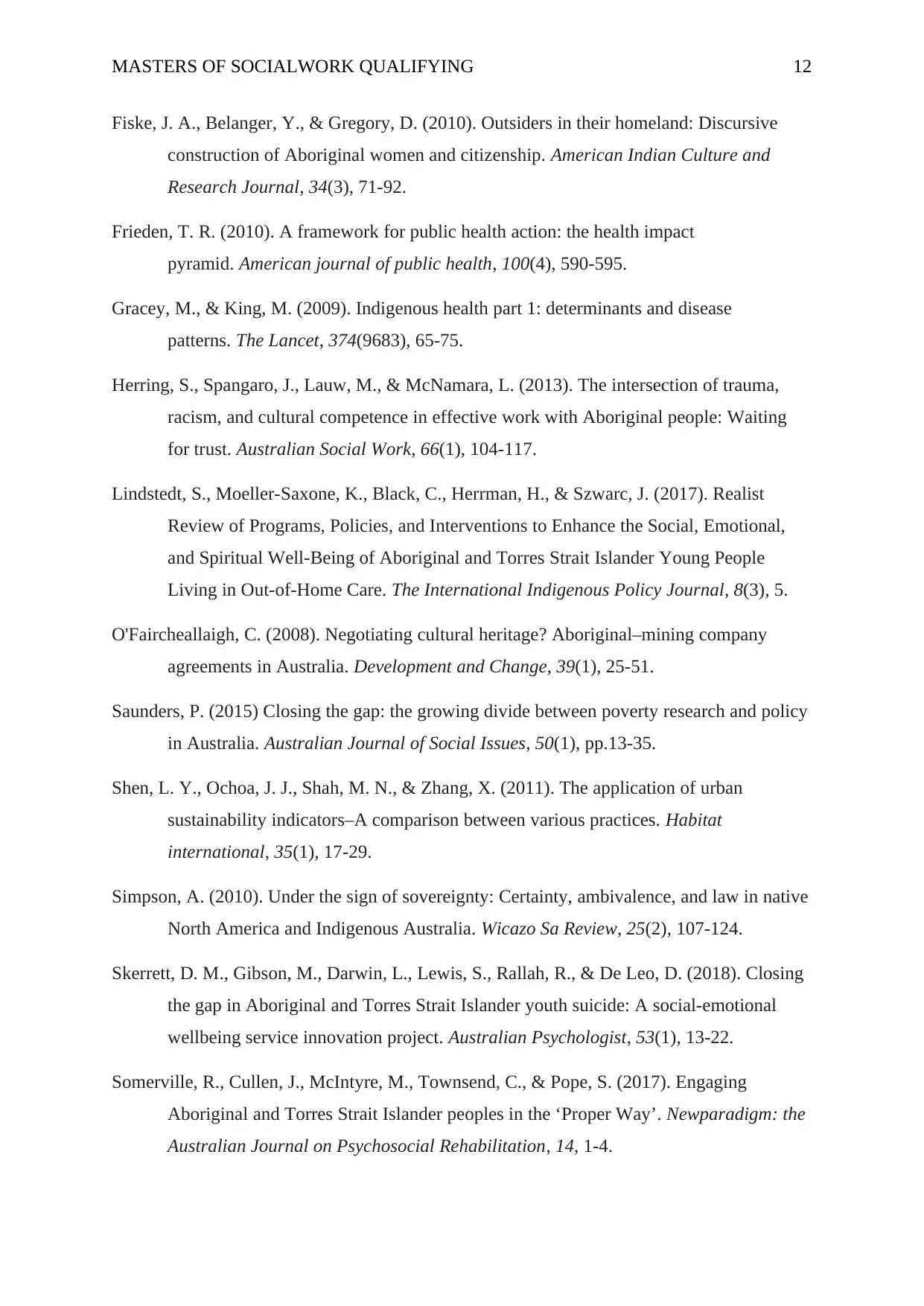
MASTERS OF SOCIALWORK QUALIFYING 12
Fiske, J. A., Belanger, Y., & Gregory, D. (2010). Outsiders in their homeland: Discursive
construction of Aboriginal women and citizenship. American Indian Culture and
Research Journal, 34(3), 71-92.
Frieden, T. R. (2010). A framework for public health action: the health impact
pyramid. American journal of public health, 100(4), 590-595.
Gracey, M., & King, M. (2009). Indigenous health part 1: determinants and disease
patterns. The Lancet, 374(9683), 65-75.
Herring, S., Spangaro, J., Lauw, M., & McNamara, L. (2013). The intersection of trauma,
racism, and cultural competence in effective work with Aboriginal people: Waiting
for trust. Australian Social Work, 66(1), 104-117.
Lindstedt, S., Moeller-Saxone, K., Black, C., Herrman, H., & Szwarc, J. (2017). Realist
Review of Programs, Policies, and Interventions to Enhance the Social, Emotional,
and Spiritual Well-Being of Aboriginal and Torres Strait Islander Young People
Living in Out-of-Home Care. The International Indigenous Policy Journal, 8(3), 5.
O'Faircheallaigh, C. (2008). Negotiating cultural heritage? Aboriginal–mining company
agreements in Australia. Development and Change, 39(1), 25-51.
Saunders, P. (2015) Closing the gap: the growing divide between poverty research and policy
in Australia. Australian Journal of Social Issues, 50(1), pp.13-35.
Shen, L. Y., Ochoa, J. J., Shah, M. N., & Zhang, X. (2011). The application of urban
sustainability indicators–A comparison between various practices. Habitat
international, 35(1), 17-29.
Simpson, A. (2010). Under the sign of sovereignty: Certainty, ambivalence, and law in native
North America and Indigenous Australia. Wicazo Sa Review, 25(2), 107-124.
Skerrett, D. M., Gibson, M., Darwin, L., Lewis, S., Rallah, R., & De Leo, D. (2018). Closing
the gap in Aboriginal and Torres Strait Islander youth suicide: A social-emotional
wellbeing service innovation project. Australian Psychologist, 53(1), 13-22.
Somerville, R., Cullen, J., McIntyre, M., Townsend, C., & Pope, S. (2017). Engaging
Aboriginal and Torres Strait Islander peoples in the ‘Proper Way’. Newparadigm: the
Australian Journal on Psychosocial Rehabilitation, 14, 1-4.
Fiske, J. A., Belanger, Y., & Gregory, D. (2010). Outsiders in their homeland: Discursive
construction of Aboriginal women and citizenship. American Indian Culture and
Research Journal, 34(3), 71-92.
Frieden, T. R. (2010). A framework for public health action: the health impact
pyramid. American journal of public health, 100(4), 590-595.
Gracey, M., & King, M. (2009). Indigenous health part 1: determinants and disease
patterns. The Lancet, 374(9683), 65-75.
Herring, S., Spangaro, J., Lauw, M., & McNamara, L. (2013). The intersection of trauma,
racism, and cultural competence in effective work with Aboriginal people: Waiting
for trust. Australian Social Work, 66(1), 104-117.
Lindstedt, S., Moeller-Saxone, K., Black, C., Herrman, H., & Szwarc, J. (2017). Realist
Review of Programs, Policies, and Interventions to Enhance the Social, Emotional,
and Spiritual Well-Being of Aboriginal and Torres Strait Islander Young People
Living in Out-of-Home Care. The International Indigenous Policy Journal, 8(3), 5.
O'Faircheallaigh, C. (2008). Negotiating cultural heritage? Aboriginal–mining company
agreements in Australia. Development and Change, 39(1), 25-51.
Saunders, P. (2015) Closing the gap: the growing divide between poverty research and policy
in Australia. Australian Journal of Social Issues, 50(1), pp.13-35.
Shen, L. Y., Ochoa, J. J., Shah, M. N., & Zhang, X. (2011). The application of urban
sustainability indicators–A comparison between various practices. Habitat
international, 35(1), 17-29.
Simpson, A. (2010). Under the sign of sovereignty: Certainty, ambivalence, and law in native
North America and Indigenous Australia. Wicazo Sa Review, 25(2), 107-124.
Skerrett, D. M., Gibson, M., Darwin, L., Lewis, S., Rallah, R., & De Leo, D. (2018). Closing
the gap in Aboriginal and Torres Strait Islander youth suicide: A social-emotional
wellbeing service innovation project. Australian Psychologist, 53(1), 13-22.
Somerville, R., Cullen, J., McIntyre, M., Townsend, C., & Pope, S. (2017). Engaging
Aboriginal and Torres Strait Islander peoples in the ‘Proper Way’. Newparadigm: the
Australian Journal on Psychosocial Rehabilitation, 14, 1-4.
Paraphrase This Document
Need a fresh take? Get an instant paraphrase of this document with our AI Paraphraser

MASTERS OF SOCIALWORK QUALIFYING 13
Stambulova, N. B., & Ryba, T. V. (2014). A critical review of career research and assistance
through the cultural lens: towards cultural praxis of athletes' careers. International
review of sport and exercise psychology, 7(1), 1-17.
Zander, K. K., & Straton, A. (2010). An economic assessment of the value of tropical river
ecosystem services: Heterogeneous preferences among Aboriginal and non-
Aboriginal Australians. Ecological Economics, 69(12), 2417-2426.
Stambulova, N. B., & Ryba, T. V. (2014). A critical review of career research and assistance
through the cultural lens: towards cultural praxis of athletes' careers. International
review of sport and exercise psychology, 7(1), 1-17.
Zander, K. K., & Straton, A. (2010). An economic assessment of the value of tropical river
ecosystem services: Heterogeneous preferences among Aboriginal and non-
Aboriginal Australians. Ecological Economics, 69(12), 2417-2426.
1 out of 14
Related Documents
Your All-in-One AI-Powered Toolkit for Academic Success.
+13062052269
info@desklib.com
Available 24*7 on WhatsApp / Email
![[object Object]](/_next/static/media/star-bottom.7253800d.svg)
Unlock your academic potential
© 2024 | Zucol Services PVT LTD | All rights reserved.





